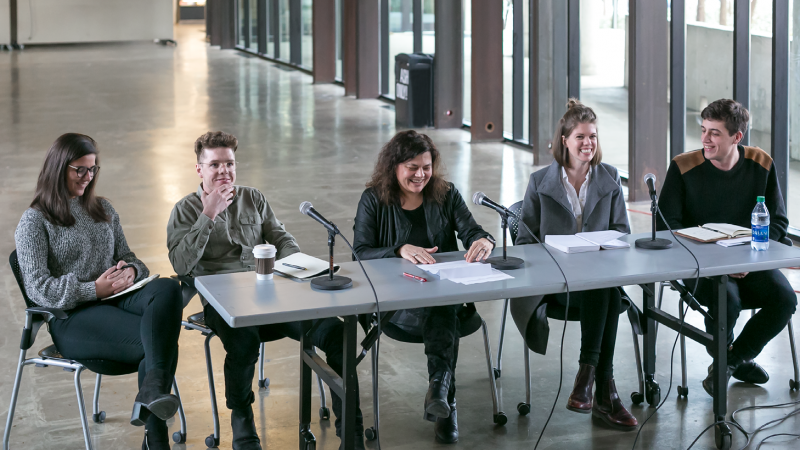Four Architecture Graduate Students Named Exit Review Finalists
“The political content of your vision, not only as it was assumed by the thinkers you quoted, but embodied in the architectural concerns and trajectories you put forward, was important for me, as well as the efficacy you assigned or assumed for architecture and architectural convention in the world at large, and the vividness with which you conjured up that register for architecture.”
—Ana Miljački, detailing her criteria for judging the Exit Review finalists’ presentations
Four third-year architecture graduate students were selected as finalists in the Master of Architecture Exit Review presentations: Ali Sandhu, Christina Tefend, Jared Younger and James Amicone. After a reading by the four finalists on March 28, guest juror Ana Miljački, Associate Professor of Architecture at Massachusetts Institute of Technology, presented to the school two winners: James Amicone’s "Porch(ness)" and Jared Younger's "Triple-W."
Compared to a design thesis, the Exit Review is a public presentation of a scholarly paper given during the last semester of a student's time in the program. The Exit Review system is unique among schools of architecture both for the way its asks design students to address the larger cultural milieu in which the discipline operates and for its extended commitment to speculative scholarly research.
James Amicone
From its roles in the Western film genre to HBO's The Wire, the porch has proved to be a scenographic staple in performance narratives as well as a highly politicized, architectural object. However, these effects as we have known them have been overlooked and underutilized in recent years, specifically in domestic architecture. James Amicone’s Exit Review, "Porch(ness)," examines the contemporary role of the porch in architecture by elucidating its architectural effects over time and proposing that the porch has reemerged under the guise of unsuspecting interests in the discipline today.
Ali Sandhu
Surface reading and symptomatic reading are terms used to describe two types of reading that have been competing in literary circles for decades. Ali Sandhu extrapolates these terms with a direct application for architecture. There are five case studies of buildings she goes on to surface read to demonstrate how this method might work within an architectural context. Then, by claiming that our contemporary society has been designed for the surface reader, she analyzes forms of commercial advertising in order to solidify her claim. It is subsequently revealed that the contemporary tendency of surface reading is a problem because the surface can be deceptive and hide reality. She then goes on the reanalyze the case study buildings introduced earlier to offer a deeper, more critical reading and prove that symptomatic reading is necessary. Sandhu would like to revive the term “both-and architecture” for our contemporary discipline. She claims there needs to be a clear tension between surface and symptomatic reading for architecture.
Christina Tefend
In her exit review, "Charged: The Political Effects of Ephemeral Architectural Magnetism," Christina Tefend calls for our personal bubbles to be literalized and emphasized through an architecture that is focused on behavior and energy, rather than material and form. Within her talk, she confronts the inequalities, desires and emotions that all too often surface within office environments, as she believes that it is here, in the workplace, that our personal boundaries, unique preferences and interpersonal relationships are tested the most. Tefend suggests an environment that uses ephemeral phenomena such as thermal, auditory and visual energies that call for a negotiation away from the homogenization of the collective, and a movement towards an emphasis on the individual. Through all of this, she cultivates a truly charged argument–in more ways than one.
Jared Younger
Object Oriented Ontology and Flat Ontology are two philosophical ideas spilling over into the discipline of architecture. With reverence and resistance to them, Jared Younger proposes an alternative way to address their architectural implications. Against Flat Ontology’s reductive stride to make different things equal and the same, he proposes embedded ontology. This is the embeddedness of wholes inside of wholes that privileges difference over sameness. This is the premise of an architecture of worlds within worlds, or "Triple-W." If flat ontology focuses on mere subjects and objects, "Triple-W" focuses on individual persons and distinct things. It is a call to privilege the complex interiorities of persons and objects by means of understanding. It is a call to look through opaque exteriors to what lies beyond.


